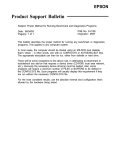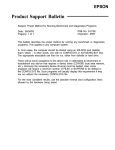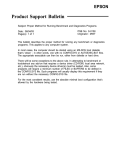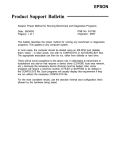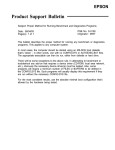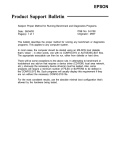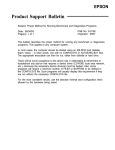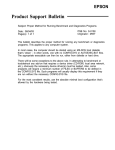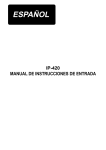Download Adaptec ACB-2322 Specifications
Transcript
EPSON Product Support Bulletin Subject: Proper Method for Running Benchmark and Diagnostics Programs Date: 06/04/93 Page(s): 1 of 1 PSB No: S-0158 Originator: MWT This bulletin describes the proper method for running any benchmark or diagnostics programs. This applies to any computer system. In most cases, the computer should be started using an MS-DOS boot diskette that’s ‘clean’ - in other words, one with no CONFIG.SYS or AUTOEXEC.BAT files. The appropriate executable can then be run, either from diskette or hard drive. There will be some exceptions to the above rule. In attempting to benchmark or troubleshoot any add-on that requires a device driver (CD-ROM, local area network, etc.), obviously the necessary device driver(s) must be loaded. Also, some programs will require a minimum number of FILES or BUFFERS to be defined in the CONFIG.SYS file. Such programs will usually display this requirement if they are run without the necessary CONFIG.SYS file. For the most consistent results, use the absolute minimal boot configuration that’s allowed by the hardware being tested. EPSON Product Support Bulletin Subject: Equity Series SIMM Compatibility Date: 12/4/91 Page(s): 1 of 1 PSB No: S-0136 Originator: JAD Due to the influx of third party SlMMs on the market, there are some that are not compatible with Epson products. This bulletin is intended to be an aid in ensuring that only compatible SlMMs are chosen for use in Epson’s Equity Series of computers. The SlMMs in question were SEIMENS, CUMULUS and KINGSTON. Installing these SlMMs in Epson products may cause the following errors: Parity Check 1 18FFFE 0000 202 Memory Address Error 164 System Options Not Set 1500 E000 201” DOS RAM Address Error It was thought that the chips used in these SlMMs were of poor quality. Epson Portland evaluated the SlMMs in question and found that this was not true. The problem is caused by the SIMM circuit boards (ITE and TECAP circuit boards) used to manufacture the SIMM modules. The dimensions of these boards are not compatible with industry standard SIMM sockets. This may result in incomplete contact between the SIMM assembly and it’s socket. This is caused by insufficient size of the contact surfaces in these products. Also enlarged holes in the TECAP product allow the component pin to pass entirely through the hole without making contact. It is recommended that only SIMMS meeting industry standard contact surface specifications be used in Epson Equity computer products. Some recommended SlMMs that were tested and found Compatible are: Toshiba Matsushita CDC Enterprises Samsung Aculogic For more information contact Technical Support. EPSON EPSON AMERICA, INC. INFORMATION Product Support Bulletin Subject: Maximum Number of Printers Supported by Current Equity Computers Date: 02/06/91 Page(s): 1 of 1 PSB No: S-0128 Originator: KAS As computing environments increase in complexity, there has been an increasing number of instances that require the support of several printers by one computer. One common example is that of using Novell Netware’s print server capabilities to provide printer access to a large group of users with differing printer requirements. Netware is capable of supporting three (3) parallel and two (2) serial printers on one server. Recent testing has shown that the Equity 386/25 Plus, Equity 386/25, Equity 386/20 and the Equity 386SX Plus will support three (3) parallel ports along with two (2) serial ports. The key factor in providing support for a third parallel port is the need for a parallel interface card that can be set to the IBM Monochrome Graphics/Parallel printer I/O address at 3BCh. The computer looks for this address first and, if present, will assign the parallel port on that card as LPT1. The built-in parallel port (I/O address 378h) will then be addressed as LPT2. We also had an AST I/O Mini serial/parallel card addressed at l/O address 278h, which was then reassigned to LPT3. Each of the three parallel ports was attached to a printer. There was also a printer attached to each of the two serial ports. All five printers were then set to print simultaneously under Netware Version 2.15 Rev. C using PCONSOLE. All five printers were able to print the documents assigned to them, simultaneously. The units were then tested using WordPerfect 5.1 on the network and again were successful in printing to the five (5) printers at the same time. The last tests were run with the units booting under DOS 4.01 and screen prints being directed to each of the printers. WordPerfect 5.1 was also used to direct documents to each of the printers. Again all five (5) printers were able to print the files that were sent to them. Although not all Equity computer models were tested in this situation, the Equity models 386SX, lIe, Ill+ and II+ should work in a similar manner if the instructions above are used as a guide. There is one item of which to be aware when using the this setup and that is the system will complete the RAM count and lock up if using a monochrome monitor. If you need to use three parallel ports, USE A COLOR MONITOR. EPSON AMERICA, INC. INFORMATION Product Support Bulletin Subject: Equity Series Computers and Lotus 1 - 2 - 3 Release 3.0 Date: Page: 12/7/89 1 of 1 PSB No: Originator: S-0108 KAS d(+# The advent of Lotus 1 - 2 - 3 Release 3.0 has raised a number of questions regarding memory management for the Epson Equity computers, specifically the Equity 386/20, Equity 386SX and Equity Ile. The purpose of this document is to discuss the memory requirements for Lotus 1 - 2 - 3 Release 3.0 and recommendations for installation. Because programs run significantly faster with extended memory, Lotus recommends that you configure as much memory as possible as extended memory. When installing Lotus 1 - 2 - 3 Release 3.0 on the Equity 386/20 or the Equity 386SX, do not use the EMS managers supplied with the system software (EEMM386.EXE for the Equity 386/20 and EMM386.SYS for the Equity 386SX). Neither of these EMS managers support the Virtual Control Program Interface (VCPI) which is required for compatibility with Lotus 1 - 2- 3 Release 3.0. NOTE: Should you require an EMS manager for your Equity 386/20 or Equity 386SX, there are third party software packages available that are compatible with Lotus 1 - 2 - 3 Release 3.0. Two such packages are 386m version 4.03 or later, and Quarterdeck Expanded Memory Manager (QEMM) version 4.2 or later. Do not use VDISK with the /E switch when running Lotus on the Equity 386/20. Though Lotus Release 3.0 will load, it will overwrite any data in the RAMDISK. VDISK supplied for both the Equity Ile and Equity 386SX is compatible with Lotus 1 - 2 - 3 Release 3.0 and does not have a problem with ovewriting data in the RAMDISK. When installing Lotus 1 - 2- 3 Release 3.0 in the Equity lIe, use the EEMM286 memory manager in the hardware - emulation EMS mode. To do this, set memory as expanded memory on the Equity lIe and do not specify the expanded memory size. When the Equity lIe has only 1Mb system memory, you must select on - board memory type 5 in SETUP. When the Equity lIe has more than 1Mb of system memory, you must select type 3, 4 or 5. Avoid the use of HDCACHE when installing Lotus 1 - 2 - 3 Release 3.0 on any of the Equity computer systems discussed in this document. EPSON EPSON AMERICA, INC. INFORMATION Product Support Bulletin Subject: Equity lIe SIMM Memory Configuration Date: 10/23/89 Page: 1 of 2 The purpose of this bulletin is to clarify information on how to set up memory configurations and use the EEMM286.sys driver with expanded memory. Setup provides 5 types of memory configurations. Type 1 shows the 640K base, disables upper 384K and displays how much additional expanded SIMM memory is installed above the initial 1MB of memory. Type 2 displays the base 640K, enables the upper 384K as expanded and displays additional expanded SIMM memory installed above the initial 1MB of memory. Type 3 displays the base 640K, disables the upper 384K and displays the additional extended SIMM memory installed above the initial 1MB of memory. Type 4 displays the base 640K, enables the upper 384K as expanded memory and displays the additional extended SIMM memory installed above the initial 1MB of memory. Type 5 displays the base 640K, enables the upper 384K as extended memory and displays the additional extended SIMM memory installed above the initial 1MB of memory. The expanded memory manager, EEMM286.SYS, will not emulate extended memory as expanded. Setup provides for expanded memory in types 1,2 or 4 and must be used with the following in CONFIG.SYS: “EEMM286.SYS /PA”. This initializes the I/O port addresses for the expanded memory and installs the EEMM286.SYS driver. This will not install if all memory is set for extended. (Re: bottom of page 6- 39 4.01 DOS manual) PSB No: S - 0107 Page 2 of 2 It is not possible to use the EEMM286.SYS driver in any other format or to specify size of memory to address in config.sys. (re: page 6- 37 4.01 DOS manual). At boot- up, EEMM286.SYS will read setup for the amount of expanded memory selected and convert it to pages, test and install the driver. MEMORY CONFIGURATION CHART Setup: Base Mem. Upper 384K Ext above 1MB Exp above 1MB Type 1 640 KB Disabled - e-s - - - - Displayed * Type 2 640 KB Enabled * Expanded --e-m- Displayed * Type 3 640 KB Disabled Displayed - - - - - - Enabled * Expanded Displayed - - - - - - Enabled Extended Displayed - - - - - - Type 4 640 KB Type 5 NOTE: 640 KB * = Requires EEMM286.SYS /PA in the config.sys file. Product Support Bulletin Subject: Equity Ile Questions and Answers Date: 9/29/89 Page: 1 of 7 Questions and Answers on the Equity Ile GENERAL: Q1. What microprocessor does the Equity Ile use? A. The Equity Ile utilizes the Intel 80286 microprocessor running at 8 or 12MHz. Use of this CPU allows for high - powered, high - speed 16 bit computing. Q2. Can the Equity Ile support an 80287 co - processor? A. Yes, 80287 support is available. The Equity Ile has a socket for an optional 80287 math co - processor which operates at 8MHz. This allows extra processing power for math intensive programs like Lotus 1 - 2 - 3 or AUTOCAD. Q3. Can the Equity Ile use option cards that are available for the IBM PC/AT? A. The Equity Ile uses an AT- compatible ISA (Industry Standard Architecture) bus structure that enables you to install most of the various add- on products designed for IBM PC, XT or AT computer, such as: expanded memory, EGA or VGA video, internal modems and many more. It also supports all of the option boards manufactured by Epson for the EQUITY series. There are 5 standard I/O expansion slots (one with 8 - bit bus and 4 with 16 - bit bus); one proprietary slot occupied by a serial/parallel interface card. The 16 - bit slots will also accept 8 bit compatible cards. The Equity Ile offers flexibility in tailoring the system to your needs. Q4. What version of DOS is provided with the Equity Ile? A. The Equity Ile includes Epson MS - DOS version 4.01. PSB No: S - 0105 Page 2 of 7 Q5. Does the Equity Ile have a built in PS/2 mouse port? A. Yes, it has a PS/2 compatible mouse port on the rear panel of the computer. The connector is a 6 pin mini DIN for an IRQ12 mouse or other device. Jumper 3 on the system board assigns IRQ12 to the mouse port or the I/O channel of other devices. Q6. Can the Equity ” + ” keyboard be used on this machine? A. The Equity ” + ” keyboards are the same as the keyboards used on the Equity Ile and are thus interchangeable, although the Ile keyboard has a longer cable. Q7. Are there any tested internal modems that can be used? A. So far only the Epson Link PC and Hayes 2400 baud internal modems have been approved. Q8. What terminal emulation boards are compatible w/ the Equity Ile? A. The following products have been tested and approved: 3278/79 Emulation Adaptor IBM 5250 Board IRMA/2 SDLC IBM IBM DCA Inc. IBM Q9. What is the Password Security? A. This system provides three levels of password protection against unauthorized access: password before boot, network - server mode password, and password disabled. The password is user - definable and consists of a 7 - byte (character) string. When the system is booted for the first time, or the password has been disabled and re - enabled by moving jumper J1 on the system board, the user defines and enables the password using the Setup utility on the Reference disk. PSB No: S-0105 Page 3 of 7 Q10. What is the Auto Speed function? A. The Equity Ile is capable of operating at 12MHz or 8MHz. Some copy protected applications require the computer to run at 8MHz while accessing the program diskette. By enabling the Auto speed function the computer automatically switches to 8MHz when accessing the diskette drive. It then switches back to 12MHz for optimal performance. Auto speed is accessed through the SETUP program under the Auto speed option. Q11. Does the Equity Ile use the Phoenix or Award ROM BIOS? A. No. All Equity computers utilize a Seiko - Epson proprietary ROM BIOS. Q12. Does the Equity Ile have a battery for the Real Time Clock? A. The Equity Ile is using a “Dallas” model DS1287 which incorporates an HD146818 compatible real-time clock with an internal battery. Q13. How many wait states does the Equity Ile have? A. At 12MHz the system utilizes a “1/4 wait state” architecture for memory access and 0 wait states for ROM BIOS access on the motherboard. At 8MHz, memory and ROM BIOS access require 1 wait state; on the I/O expansion bus, 16 - bit memory or device requests require 1 wait state while 8 bit memory or device requests require 4 wait state. If additional wait states are required, devices on the I/O channel hold the READY signal low thus wait states are generated until the device can respond to the CPU. Q14, A. How many jumpers are on the system board? There are three (3) jumpers on the system board: Jumper 1: Password Enable/Disable A: Enable (Default) B: Disable Jumper 2: P - ROM type A: 256KBit (Default) B: 128KBit Jumper 3: IRQ12 Assignment A: IRQ12 dedicated to the auxiliary mouse port. (Default) B: IRQ12 available to devices on the I/O channel. PSB No: S-0105 Page 4 of 7 Q15. What VGA adapters are compatible with the Equity Ile? A. The following VGA adapters have been tested in the EQ Ile: Epson VGA Plus 16 card. Paradise VGA Plus 16 Card Paradise VGA Professional Card Video Seven Fastwrite Card HARD DRIVES: Q16. What type of hard disk drives are available for the Equity Ile? A. The Equity Ile is available in one hard disk configuration using a 40Mb 3.5” hard disk, (Conner CP - 344, 29ms access time). This hard disk drive offers a 1:1 interleave, using an embedded controller with an AT interface with Drive Type 59. Q10. What extended hard drive support is available in the ROM BIOS that comes with the Epson Equity Ile? A. The Seiko - Epson BIOS will directly support hard drives that range in size from 10Mb to 304Mb. There is direct support for the Seagate ST 251 and the ST- 4096 hard disks, as well as, several ESDI drives. By providing this support for 3rd party hard disk drives, the Equity Ile has the capability to use most 3rd party 8- bit and 16 - bit hard disk controllers. SCSI drives have their own controllers attached to the drive and should work correctly when attached to the bus with a host adapter. There is a provision for setting up hard disk drives that are not supported by the Equity Ile Drive Type Table. In SETUP, a sub- menu lists the settings you can change for each drive: the number of cylinders (tracks), the number of read/write heads, the number of sectors, the precompensation cylinder, the landing zone (the cylinder on which you want to park the heads when moving the computer), and the total storage capacity in megabytes. Q11. What hard drive controller is used in the EQ Ile? A. The EQ Ile uses a AT- interface type controller embedded in the hard drive. This controller connects to a Task File Host interface (LYNX- HI board) that is attached to the LYNX system board. PSB No: S-0105 Page 5 of 7 Q12. A. Does the Epson Hard Disk Interface require an expansion slot? No. The Epson Hard Disk Interface interconnects the system board with an AT- interface type hard disk through a dedicated connector. Q14. Can the floppy disk interface be disabled? A. No. The floppy disk interface is integrated on the system board and there are no jumpers to disable it. Q15. Can the Epson Hard Disk Controller be disabled or its address changed? A. Yes. There are five jumpers on the LYNX- HI board for altering its function, J1 through J5: Jumper 1: Reserved Jumper 2: Reserved Jumper 3: Reserved Jumper 4: Hard Disk Controller I/O port address A: Primary (1F0H - 177H, 3F6H, 3F7H) B: Secondary (170H - 177H, 376H, 377H) Jumper 5: Hard Disk Controller Enable/Disable A: Enable B: Disable Q16. A. Can the Equity Ile use other hard disk drives and controllers? Yes, the Lynx- Hi board can be disabled and other SCSI, ESDI, MFM type controllers and drives can be used. Other AT- interface drives can be connected to the Lynx - Hi board as well. FLOPPY DRIVES: Q17. What types of floppy disk drives will work on the Equity Ile? A. The Equity Ile will support 5.25”, 1.2Mb (standard) and 360Kb halfheight floppy disk drives. To provide industry wide compatibility, the support for both 1.44Mb and 720Kb, 3.5” floppy disk drives is also provided. PSB No: S-0105 Page 6 of 7 Q18. Will the Equity Ile support 3 floppy disk drives? A. No, not directly. The Epson controller and ROM BIOS supports a maximum of two floppy drives. The internal floppy controller cannot be disabled or removed. RAM MEMORY: Q19. What SIMM chips should be used when adding memory to the Equity Ile? A. Use the Epson 80 ns SIMM module kits, either 1 MByte kit, (256Kb SIMMs) or 2MByte kit, (1Mb SIMMs) to extend the system memory. Should you need to use third party SIMM modules we recommend the following: 1 MBit x 9 80 ns Toshiba 1 MBit x 9 80 ns CDC Enterprises 1 MBit x 9 80 ns Samsung 1 MBit x 9 80 ns Matshushita **NOTE** The following SIMM chips do not work in the Equity Ile: IBM Panasonic Compaq NMBS Q20. How do I increase the memory of the Equity Ile? A. The standard Equity Ile system includes 1 Mb of on - board memory. You can add SlMMs (single in - line memory modules) to increase the amount of on - board memory in the computer. With added SIMMs, the total amount of on - board memory in the computer must be one of the following: 2Mb, 3Mb, or 5Mb. There are four SIMM sockets inside the Equity Ile. Each socket can contain one 256Kb or 1Mb SIMM. The following table shows possible SIMM configurations for the Equity Ile. Total Memory* 1Mb 2Mb 3Mb 5Mb Socket 1 Socket 2 Socket 3 Socket 4 256Kb 1Mb 1Mb 256Kb 1Mb 1Mb 256Kb 256Kb 1Mb 1Mb * Includes the standard 1MB of System memory. Memory can also be expanded through use of third party memory boards. PSB No: S-0105 Page 7 of 7 Q21. What type of RAM chips are used in the Equity Ile? A. The Equity Ile utilizes eight (8) 514256 - 10 (256x4), 100 ns RAM chips plus parity on the system board. Q22. Does the Equity Ile have Shadow RAM? A. No, due to the use of faster ROMs in the BIOS, there is no need for Shadow RAM. Q23. How can I use the 384K of memory between the 640K and the 1MB range? A. The memory up to 1MB is used as extended memory and any extended memory above 1MB can be used as extended or expanded by utilizing the EEMM286 utility supplied with the Equity Ile. SOFTWARE: Q24. Is the Equity Ile compatible with OS/2? A. Yes, since OS/2 is much more hardware- specific than MS- DOS, the Epson version of MS OS/2 is required. Q25. Will it support Unix and/or Xenix? which versions? A. The Equity Ile has been tested w/ Santa Cruz Operations Xenix Rel. 2.1 and IBM PC Xenix Vers. 1. Subject: Using High Capacity ESDI and SCSI Hard Disk Drives with the Current Equity Series Computers Date: 10/10/90 Page(s): 1 of 2 PSB No: S-0091A Originator: PNM The purpose of this bulletin is to provide some specific examples of how to install high capacity ESDI and SCSI hard disk drives in the current Equity Series computers. The largest drive directly supported by the ROM BIOS (ver 220) in the Equity II+ and Equity Ill+ has a capacity of 130Mb, while the largest supported directly by the ROM BIOS in the Equity lIe, 386SX, 386/20 and 386/25 is 153Mb. To allow our units to be used in stand alone and especially network environments that require higher drive capacities, the use of the Adaptec ACB 2320 controller (available with the Equity 386/20) with the optional ACB-BIOS (available from Adaptec) will provide support for a variety of ESDI drives up to 314Mb. The AC&BIOS also has the ability to read the ESDI drive parameters from the drive itself. This will allow it to configure virtually any ESDI drive. NOTE: The Adaptec BIOS ROM should be installed in location U25. In order for it to work, the jumper J13 pin 1 must be installed. Caution should be used when ordering the BIOS ROM as problems have been experienced when using version B. Versions A and C perform normally. The WD1007V-SE1 controller is another option that can be used with high capacity ESDI drives that are not supported by the ROM BIOS drive tables. When using this controller’ make sure that all pins on jumper on W1 are open. You can run SETUP and use Type 1 for the drive type or let the controller automatically set it at the end of the low level format routine provided by the controller’s BIOS. To start the WD-BIOS Format Utility, run DEBUG and enter G=CC00:5. This will bring up a menu listing the operations that are available. Run the low level format and either enter the defective blocks listed on the drive by hand or let the program enter them automatically. Continue with the “Verify” and “Surface Analysis” utilities and finally finish with the “Set Drive Type and Exit". At this point there are 5 options from which to choose using the “+” and ‘I-” keys to toggle through the available choices. Select the ‘Translation Option-63 SPT (Sectors Per Track)” if the hard drive has more than 1024 cylinders or “Non-Translation” for drives with less than 1024 cylinders. PSB No: S-0091A Page: 2 of 2 The next step after completing the low level format is to run the Novell COMPSURF utility. When setting up the COMPSURF Parameters it will ask if you want to “Format the drive?” where you will choose the “NO” response and proceed to the next option. When asked if you want to “Retain the Bad Track Table” answer ‘YES” and continue on with the rest of the COMPSURF options. After completion of the COMPSURF utility, continue on with the rest of the NETGEN installation. The use of high capacity SCSI drives is another area where we are able to provide a solution for those customers who require storage capacities greater than the Epson Supplied options. When using a SCSI type hard disk drive, the hard disk controller usually is a part of the hard drive unit. The connection between the SCSI bus and the Equity’s data bus is made by installing a host adaptor into the Equity computer and connecting the SCSI drive to the host adaptor. The Seagate ST-296N, 85Mb drive, used in a stand alone configuration in the current Equity Series computers has provided favorable results. When using SCSI drives in a Novell network, the use of the Future Domain SCSI adaptor with high capacity SCSI drives such as CDC and Maxtor has also been very successful. Future Domain recommends using Version 1.4 of their device driver when installing Novell Netware Versions 2.1-2.15. When used with the TMC-830 (use ROM Vers. 4.0L) or the TMC-840 (use ROM Vers. 5.0C) host adapters, drive sizes of up to 800Mb (CDC 94181-702) can be accommodated. Product Support Bulletin Subject: Equity and Apex Series Compatibility with the Sysgen OmniBridge Controller and BridgeFiler External Floppy Drives Date: Page: 04/11/90 1 of 3 PSB No: Originator: S-0088B KAS 60 The purpose of this bulletin is to provide the results of compatibility testing conducted by the Computer Product Support Center with the Sysgen OmniBridge controller and Bridge - Filer external floppy disk drives. Comments Equity I The Equity I was found compatible with the OmniBridge controller. It was able to support one or two external disk drives (daisychained) together. The external drives could be used as high density (1.2M and 1.44M) or normal (360K and 720K) disk drives. Equity II The Equity II was found to be totally incompatible with the OmniBridge controller. Equity III The Equity III was found compatible with the OmniBridge controller. It was able to support one or two external disk drives (daisychained) together. The external drives could be used as high density (1.2M and 1.44M) or normal (360K and 720K) disk drives. Equity I + The Equity I + was found compatible with the OmniBridge controller. It was able to support one or two external disk drives (daisychained) together. The external drives could be used as high density (1.2M and 1.44M) or normal (360K and 720K) disk drives. Equity le The Equity le was found compatible with the OmniBridge controller. It was able to support only one external floppy drive, unlike the other models tested. The drive could be used as a high density (1.2Mb and 1.44Mb) or normal (360K and 720K) disk drive. PSB No: S-0088B Page: 2 of 3 Equity II + The Equity II + was found compatible with the OmniBridge controller. It was able to support one or two external disk drives (daisychained) together. The external drives could be used as high density (1.2M and 1.44M) or normal (360K and 720K) disk drives. Equity lIe The Equity Ile was found compatible with the OmniBridge controller. It was able to support one or two external disk drives (daisychained) together. The external drives could be used as high density (1.2M and 1.44M) or normal (360K and 720K) disk drives. Equity Ill + The Equity III + was found compatible with the OmniBridge controller. It was able to support one or two external disk drives (daisychained) together. The external drives could be used as high density (1.2M and 144M) or normal (360K and 720K) disk drives. Equity 386SX The Equity 386SX was found compatible with the OmniBridge controller. It was able to support one or two external disk drives (daisychained) together. The external drives could be used as high density (1.2M and 144M) or normal (360K and 720K) disk drives. Equity 386/20 The Equity 386/20 was found compatible with the OmniBridge controller. It was able to support one or two external disk drives (daisychained) together. The external drives could be used as high density (1.2M and 1.44M) or normal (360K and 720K) disk drives. APEX The Epson APEX was found compatible with the OmniBridge controller. It was able to support one or two external disk drives (daisychained) together. The external drives could be used as high density (1.2M and 1.44M) or normal (360K and 720K) disk drives. APEX + The Epson APEX was found compatible with the OmniBridge controller. It was able to support one or two external disk drives (daisychained) together. The external drives could be used as high density (1.2M and 1.44M) or normal (360K and 720K) disk drives. PSB No: S-008B Page: 3 of 3 APEX 100 The Epson APEX 100 was found compatible with the OmniBridge controller. It was able to support one or two external disk drives (daisychained) together. The external drives could be used as high density (1.2M and 1.44M) or normal (360K and 720K) disk drives. APEX 200 The Epson APEX 200 was found compatible with the OmniBridge controller. It was able to support one or two external disk drives (daisychained) together. The external drives could be used as high density (1.2M and 1.44M) or normal (360K and 720K) disk drives. NOTE: The recommended switch settings for the OmniBridge controller are as follows: 1-1 1-2 1-3 1-4 DOWN DOWN DOWN DOWN 2-1 2-2 2-3 2-4 DOWN DOWN UP UP These settings select NO ADDRESS for the OmniBridge BIOS and allow it to coexist with the internal FDC of the computer in which it is being installed. This way you do not need to disable the internal FDC or connect any cables from the OmniBridge to internal floppy drives. This was found to be a universal setting for all of the computers listed above as compatible with the OmniBridge controller. PSB No.: S-0062I Page: 1 of 18 EQUITY II+ (12MHz) VER 2.20 2.20 Y162802001 Y162803001 PART # DESC TYPE LOC 3.00 3.00 Y162802002 Y162803002 ADR-A3 ADR-B3 M27C128 M27C128 3B 4B 3.03 3.03 22011035 22011036 ODD303 EVEN303 M27C128 M27C128 SEE NOTE ADR-A2 ADR-B2 M27C128 M27C128 3B 4B REASON Fixed problems with serial port and Microsoft Word, Intel InBoard 386 and CTRL key. See ECN EQII+-001 (4/15/88). To allow the use of the ADAPTEC ACB-2322B ESDI controller. See ECN EQII+-005 (2/6/91). To resolve the problem that causes the inability to format double density diskettes in high density FDDs with DOS 5.0 installed. NOTE: For ADR-RM3 and ADRRM5 boards, ODD303 should be placed in location 4B and EVEN303 in location 3B. For ADR-RM4 boards, ODD303 should be placed in location 3B and EVEN303 in location 4B. See ECN EQII+-006 (4/2/93). EQUITY IIe VER 1.06 1.06 1.07 1.07 1.13 1.13 PART # Y186807002 Y186806002 Y186807003 Y186806003 Y186807004 Y186806004 DESC LNX-B03 LNX-A03 LNX-B04 LNX-A04 CLNX-BO5 CLNX-AO5 TYPE 27C256 27C256 27C256 27C256 27C256 27C256 LOC 11E 14F 11E 14F 11F 14E REASON INITIAL RELEASE Fixes problem with the SMD-449L (1.44MB FDD) seek error and 720K being accessed at 300KB. To allow remote boot from DEPCA network adapter. To allow the expanded use of IDE hard drives (ST157A, Quantum,Maxtor, Rodime, Western Digital). To allow the use of Imprimis and Conner IDE drives in two drive configurations. To allow proper initialization when executing a warm boot. See ECN EQIIe-002 (2/6/91).



















